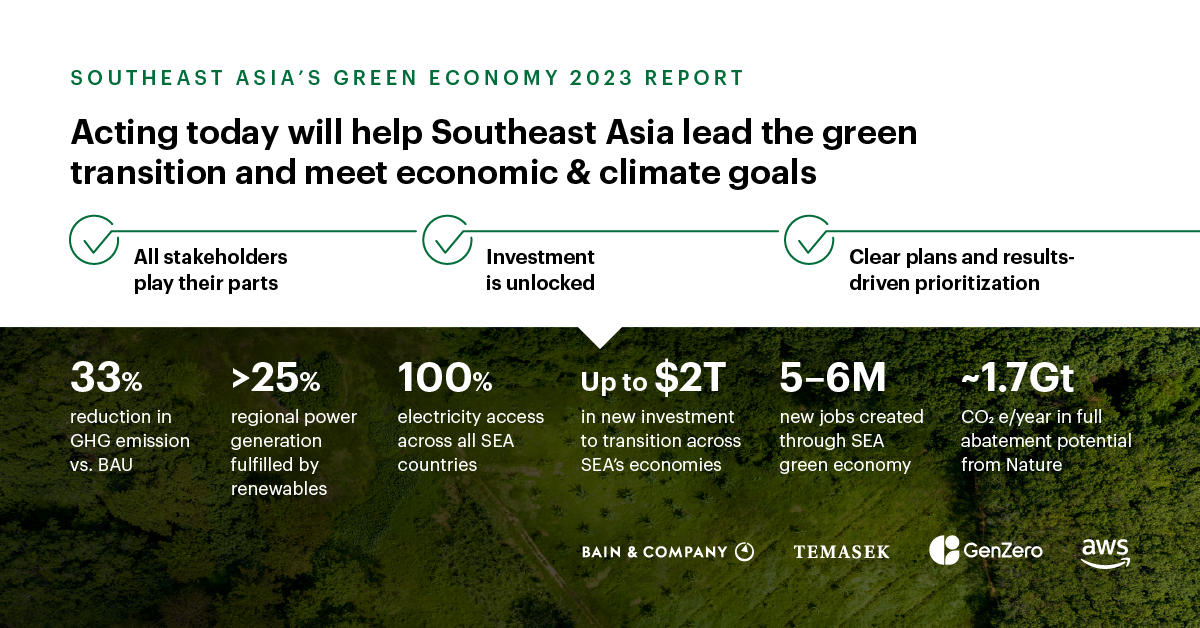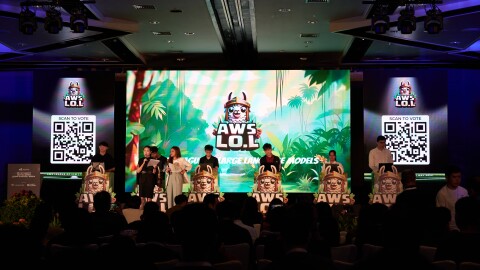The recently released Southeast Asia Green Economy Report 2023: Cracking the Code, developed collaboratively by Bain & Company, Temasek, GenZero and AWS, identifies some of the biggest challenges on the region's road to Net Zero greenhouse gas emissions, while highlighting some of the most impactful actions we can take today to accelerate this transition.
According to the report, an estimated US$2 trillion (SGD$2.7 trillion) in investments must be fast-tracked if governments in Southeast Asia (SEA) are to meet their unconditional Nationally Determined Contribution targets by 2030. This is relative to current green capital flows of a little more than US$5 billion, of which the majority is allocated to renewable energy projects.
Focusing on energy and nature solutions will be particularly important to fulfil regional climate commitments, as these sectors account for nearly 85% of SEA’s total emissions reduction targets. Rapidly deploying scalable, proven solutions in these sectors is crucial to meet both nearer-term opportunities for green growth, as well as longer-term Paris Agreement targets.
Cloud as an immediately deployable solution to decarbonize and innovate
One immediate first step that public and private sector organizations in SEA can take towards decarbonization is to embrace cloud computing. Organizations in the region that move IT workloads from on-premises data centers to cloud can lower the related carbon footprint by nearly 80% due to the highly energy-efficient cloud data centers. The decarbonizing opportunity increases further—to up to 96%—when cloud infrastructure operates on 100% renewable energy, a goal AWS is on a path to achieve by 2025. Once on AWS, customers can monitor their carbon footprint in the cloud and optimize their IT workloads to further reduce energy use and associated emissions, while also reducing costs.
The report also highlights the importance of private-sector investments and leadership in facilitating, deploying and scaling innovative, high-impact technology solutions. According to the International Energy Agency, cloud-enabled technologies such as artificial intelligence, machine learning, Internet of Things and edge computing are critical to accelerating transformations at scale.
At AWS, we increasingly see customers finding value at the intersection of digital technologies and sustainability. These are some examples of the many AWS customers in SEA already building impactful sustainability solutions:
- Rekosistem, an end-to-end zero-waste-management startup, is building on AWS to improve Indonesia’s waste value chain;
- Restorify, built on AWS by Razer, a leading lifestyle brand for gamers, offers a carbon footprint calculator integrated into all aspects of its online marketplace, with carbon offset options at checkout;
- Maxeon Solar Technologies leverages the operational efficiency, reliability and security of the AWS cloud to drive faster innovation in solar power generation;
- Energy Response Co Ltd (ENRES), an AWS-powered sustainability startup in Thailand, is creating AI-powered solutions to increase energy efficiency in large buildings and factories across Asia.
Collective action an imperative to scale
As the report highlights, collaboration between the public and private sectors and civil society will be critical to scaling solutions in SEA. Amazon, for example, is engaged with industry groups such as the Asia Clean Energy Coalition, where we are a founding member, and the Clean Energy Investment Accelerator group in the region to expand renewable energy access.
Corporate renewable energy investments already account for much of the world’s new renewable power projects today, and will be particularly crucial in helping SEA accelerate its clean energy transition. On top of investment and associated capital, corporate renewable energy procurement helps create green jobs and grow domestic clean energy industries, without taxpayers needing to bear additional cost burdens.
The report also finds that while the pipeline of renewables projects in the region is impressive—194 gigawatts' worth—90% remain stuck in permitting and accounting stages. Resolving this backlog and addressing regional transmission challenges will unleash significant additional market opportunities.
In Singapore alone, more than half of the country’s power will need to come from cross-border renewable power imports by 2050. An estimated $1.1 trillion of investments is needed in clean and efficient energy in SEA. Amazon, the world’s largest corporate purchaser of renewable energy, is committed to contributing to this. To date, in the region, we have announced first-in-market agreements for 210 megawatts (MW) of new renewable capacity in Indonesia, as well as two utility-scale projects in Singapore—a 62MW solar project with Sunseap, and a 17.6MW solar project with Sembcorp.
Unlocking nature-based solutions in the region
On nature, the report finds that protecting, restoring, and sustainably managing natural ecosystems will contribute nearly 41% of 2030 emission reduction targets for SEA, and represents a potential US$20 billion to US$30 billion annual investment opportunity.
At Amazon, we actively invest in nature-based solutions to mitigate emissions outside of our value chain and supplement operational decarbonization efforts. In SEA specifically, we established the International Blue Carbon Institute last year together with Conservation International, to help mitigate climate impact and protect coastal communities by restoring and protecting coastal and marine ecosystems such as mangroves, seagrasses and tidal marshes.
This “blue carbon” opportunity is particularly large in SEA, which is home to one-third of all of the world’s mangroves, one of nature’s greatest carbon sinks.

The SEA report concludes that accelerating SEA’s decarbonization transition and enabling regional economic and climate ambitions at the same time is doable, but will take collective action and development of clear, results-driven prioritization plans.
Embracing the right path forward to build a robust and green economy would reduce SEA’s greenhouse gas emissions by 33% compared to today’s business-as-usual scenario, while capturing up to US$2 trillion in new economic opportunities, and creating more than five million additional jobs by 2030. And cloud computing is a key enabler to help SEA unlock its climate action potential over the next decade and beyond.











